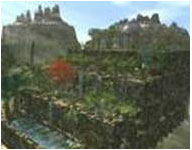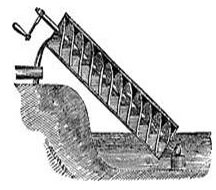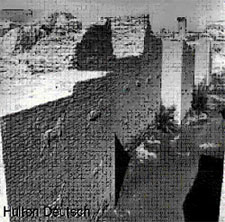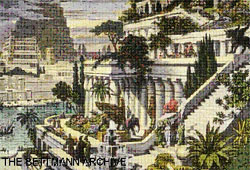By: Charlene Rennick
“; } ?>
Many new devices, ideas and civilizations have emerged because, “Necessity is the mother of invention” (Plato, The Republic). The shortage of water and available fertile soil for planting crops is not a new issue. Throughout history, archaeological evidence shows us that thousands of cities have been built on land that was safe from invasion, but not necessarily ideal for agricultural use. People have been using water and rock in place of soil to support plant growth for centuries.
Nebuchadnezzar, ruler of ancient Babylon during the Chilean dynasty in 600 BCE, built the hydroponically-engineered gardens in the palace courtyard located just outside of present day Baghdad, Iraq. The rumour is that he had these constructed to please his wife, Amytis of Media, because she was homesick for her childhood home in the mountain springs.

The First Hydroponic Pump
The garden climbed upward in a staircase-style that resembled a small, lush tropical mountain. According to some theories, the water was pumped from a central source at the base of the palace by a mechanism called, Archimedes’ screw. The screw is made of one continuous rotating unit located inside a cylinder. When the handle is turned, it moves water from a lower level and deposits it into a higher level. Irrigation tunnels would have dispersed the water to the rest of the gardens.
 Although pine pitch could have been used to extend the life of the material used to construct the screw, or as a water-proof coating, it was not necessary. Any water that leaked from one level of the screw to a lower level inside would have been scooped up by the lower level and continued to be moved along to the top of the cylinder for pouring. There have been other discoveries of Archimedes’ screw found as far north as Sweden (Wikipedia).
Although pine pitch could have been used to extend the life of the material used to construct the screw, or as a water-proof coating, it was not necessary. Any water that leaked from one level of the screw to a lower level inside would have been scooped up by the lower level and continued to be moved along to the top of the cylinder for pouring. There have been other discoveries of Archimedes’ screw found as far north as Sweden (Wikipedia).
Where Was Babylon?
Babylon was the capital of Babylonia from about 2000 to 1000 BCE. It was strategically located on the best possible route between the lands that connected the Mediterranean Sea with the Persian Gulf. By 1894 BCE, Babylon had become a powerful independent city-state.
Unfortunately, it was captured by Hittites in 1595 BCE and fell under the rule of the Kassite dynasty for the next century. During this period, the Kassites took over all of Mesopotamia and made Babylon the capital city. Religious rituals gravitated here after it became the centre of political power and a temple was erected to honour the god, Marduk.
Babylon was ransacked by warfare until about 600 BCE when Nabopolassar expelled the Assyrians and began to rebuild the ravished city. He and his son, Nebuchadnezzar refurbished the palace, the city gates and temples. Their reign of triumph was short-lived; Babylon was captured by Cyrus the Great in 539 BCE, a Persian ruler who levelled the religious temples and destroyed all the images of Marduk.
Babylon remained a major Persian trade centre until Alexander the Great captured it in 330 BCE. He died shortly after his victory and never got a chance to do anything with it. For the next 600 years, no one seemed to have an interest in Babylon, probably because by this time, it had been reduced to a pile of rubble. It was only refurbished again around 7th century CE when the Islamic empire began its move south.
Dusting off the Ruins
Previous to WWI, the land was excavated. The ruins of the palace and temples at the Euphrates river were discovered. Close by, the Ishtar gate was unearthed. Its brightly carved lions and dragons were re-introduced to the world. We get the image of lavishly decorated religious and political leaders entering the city through this gate during festivals and cult ceremonies. The Ishtar Gate was one of nine gates through which the city of Babylon could be entered. (Photos courtesy of www.geocities.com/Pipeline/4966/garden.html)


My daughter haas a project to do , recreating the Babylonian Gardens. I’m having a hard time finding pictures. Where can I find more or do you have any that can be sent via e-mail?
Hi Brandie,
Have you tried searching google images? I just did a search and found a bunch. Try the link below:
http://www.google.com/images?hl=en&source=imghp&q=hanging+gardens+of+babylon&gbv=2&aq=0&aqi=g10&aql=&oq=hanging+gard&gs_rfai=
Best of luck with the project!
Charlotte